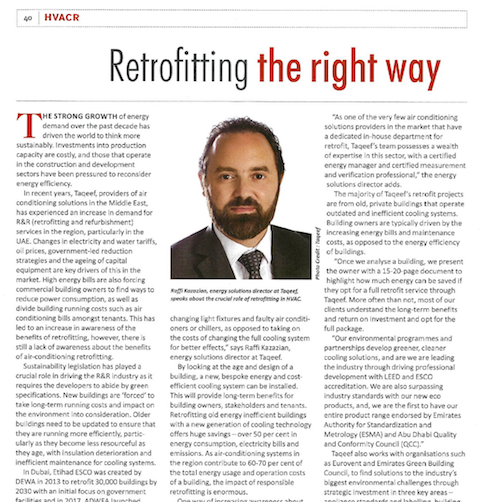

The strong growth of energy demand over the past decade has driven the world to think more sustainably. Investments on production capacity are costly, and those that operate in the construction and development sectors have been pressured to reconsider energy efficiency.
In recent years we have experienced an increase in demand for R&R (retrofitting & refurbishment) services in the region, particularly in the UAE. Changes in electricity and water tariffs, oil prices, government-led reduction strategies and the aging of capital equipment are key drivers of this in the market. High energy bills are also forcing commercial building owners to find ways to reduce power consumption, as well as divide building running costs such as air conditioning bills amongst tenants. This has led to an increase in awareness of the benefits of retrofitting, however, there is still a lack of awareness about the benefits of air-conditioning retrofitting.
Sustainability legislation has played a crucial role in driving the R&R industry as it requires developers to abide by certain green specifications. New buildings are forced to take long-term running costs and impact on the environment into consideration. Older buildings need to be updated to ensure that they are running more efficiently, particularly as they become less and less resourceful as they age, with insulation deterioration and inefficient maintenance for cooling systems.
In Dubai, Etihad ESCO was created under DEWA in 2013 to retrofit 30,000 buildings by 2030 with an initial focus on government facilities and last year, ADWEA launched Kafa’ati – a building retrofit initiative as part of the Tarsheed DSM programme. We have also seen similar initiatives in Oman, KSA and Jordan, so this drive to be more sustainable is region wide.
These legislations are necessary in terms of setting guidelines, however, many developers and building owners aim to achieve the minimum requirements set, instead of aiming for the maximum energy efficiency that the building is capable of. As a result, we are witnessing shallow retrofits across the industry – developers and building owners opt for quick fixes, such as changing light fixtures and faulty air-conditioning units or chillers, as opposed to taking on the costs of changing the full cooling system for better effects.
By looking at the age and design of a building, a new, bespoke energy and cost-efficient cooling system can be installed. This will provide long-term benefits for building owners, stakeholders and tenants. Retrofitting old energy inefficient buildings with a new generation of cooling technology offers huge savings – over 50% in energy consumption, electricity bills and emissions. As air-conditioning systems in the region contribute to 60-70% of the total energy usage and operation costs of a building, the impact of responsible retrofitting is enormous.
One way of increasing awareness about air-conditioning energy usage and reducing the number of shallow retrofits done by developers and building owners would be to increase tariffs. By doing so, end-users will be more energy-conscious and, ultimately, building owners are driven to implement energy retrofits.
In response to the increased demand in R&R solutions, Taqeef created an Energy Solutions Division in 2016 to offer a number of environmental services, including retrofit – with a focus on all five cooling technologies: water and air-cooled chillers, variant refrigerant flow (VRF), ducted and split units.
As one of the very few air conditioning solutions providers in the market that have a dedicated in-house department for retrofit, our team possess a wealth of expertise in this sector, with a certified Energy Manager and certified Measurement and Verification professional.
The majority of our retrofit projects are from old, private buildings that operate outdated and inefficient cooling systems. Building owners are typically driven by the increasing energy bills and maintenance costs, as opposed to the energy efficiency of buildings. We are approached to support with upgrading these systems and implementing individual metering for apartments to divide the cost amongst stakeholders and end users.
Once we analyse a building, we present the owner with a 15-20-page document to highlight how much energy can be saved if they opt for a full retrofit service through Taqeef. More often than not, most of our clients understand the long-term benefits and return on investment and opt for the full package.
Our environmental programmes and partnerships develop greener, cleaner cooling solutions, and are we are leading the industry through driving professional development with LEED and ESCO accreditation. We are also surpassing industry standards with our new eco products, and, we are the first to have our entire product range endorsed by Emirates Authority for Standardization and Metrology (ESMA) and Abu Dhabi Quality and Conformity Council (QCC).
We are also committed to going beyond our legislative duties, through working with organisations such as Eurovent and Emirates Green Building Council, to find solutions to the industry’s biggest environmental challenges. Through strategic investment in three key areas – appliance standards and labelling, building retrofit, and district cooling.
National initiatives currently in place suggest that the UAE is the most active in the R&R space, driving the business faster than the other countries in the region. It has also served as a catalyst for the region in the renewable and efficient energy sectors. It is important for key players in the HVAC industry to take advantage of these initiatives and further raise awareness of the benefits of R&R, particularly for those in the air conditioning sector in this market given the harsh climate conditions.
The current environmental regulations in place are having a positive impact on the HVAC industry. As we continue to support the environmental agenda through innovation and investment, we welcome more stringent regulations in respect to air conditioning that will ultimately push building owners and developers to ensure their systems are running as efficiently as possible.